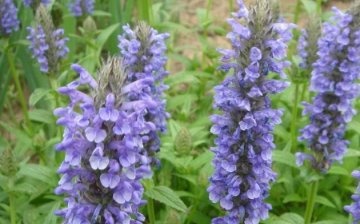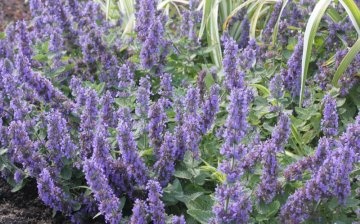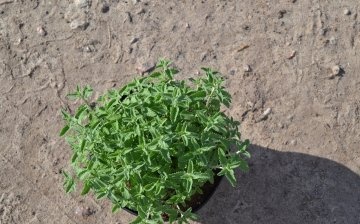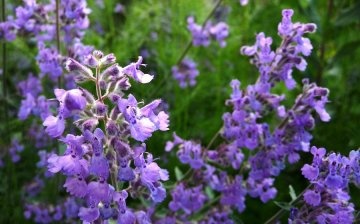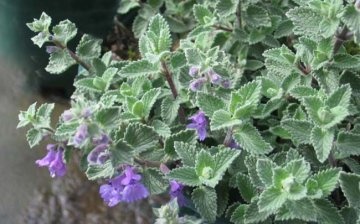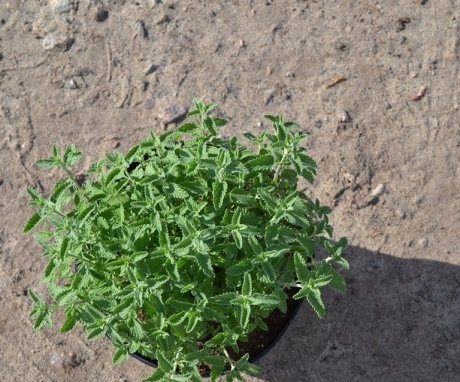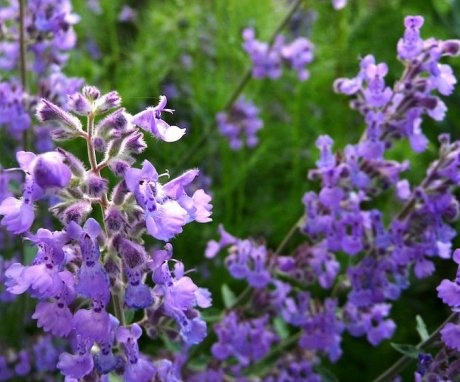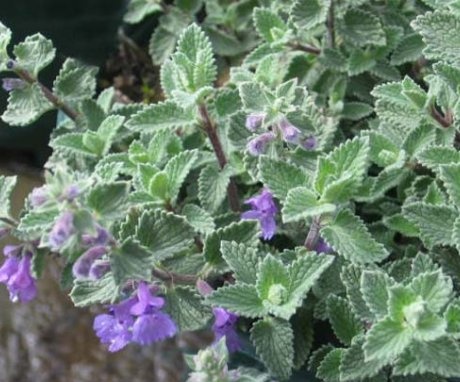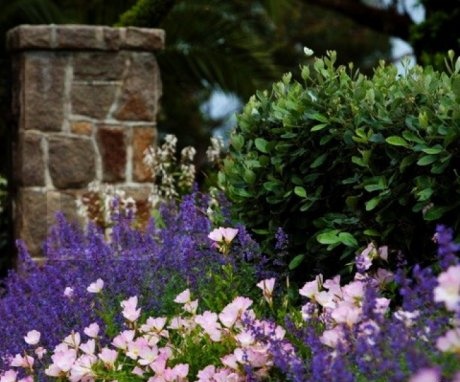Fassen's Catnip - application and cultivation
The history of the origin of the name of the plant is not exactly known, but the aroma, like a magnet, attracts feline representatives. Not only cats like the Fassen cattle, it is also actively used in aromatherapy. The essential oil from the flowers of the plant relaxes well and increases the emotional tone.
In medieval times catnip attributed magical properties. With his help, they bewitched the chosen one, putting dried flowers under his pillow. The sorcerers used the powdered herb to summon evil spirits to gain power over the beasts.
Content:
- Features of Fassen's catnip
- Planting rules
- Breeding methods for catnip
- Plant care tips
- What can threaten the catnip and how to deal with it
Features of Fassen's catnip
Fassen's cattle (Nepeta faassenii) is distinguished by a long and abundant flowering and has a resemblance to flowers lavenderand the scent attracts cats like scent valerian... The natural area of the plant is North American, Asian and European countries, therefore it is mainly grown in the middle and southern lane. The optimal condition for development is a temperature regime within 15-22 degrees.
Fassen's catman is not only able to decorate the local area, but is also actively used in aromatherapy.
Fassena is a descendant of the catnip nepetella and mussini. An adult plant reaches a height of just over half a meter. During the flowering period, the bushes are densely covered with fragrant flowers, therefore it is actively used in landscape design for decoration curbs and alpine slides. Combines effectively with roses.
The shoots of the Fassen catnip are covered with grayish-green leaves, and the elongated inflorescences strewn with flowers have various lilac-purple shades. It blooms from early summer to mid-autumn, but repeated flowering is possible if faded inflorescences are removed in time.
Most often, three plant varieties can be found in flower beds:
- "Six Hills Giant" reaches a height of 60 cm and is distinguished by rich blue inflorescences. Flowering period May-September.
- "Blue Wonder" is a dwarf variety that grows no higher than 22 cm. It forms inflorescences of the color of a clear sky with a bright azure tint. With the correct landing, you can achieve the illusion of a running stream.
- "Walkers Low" plant half a meter high, forms lavender flowers.
Fassena cattle belongs to ornamental plants and has no medicinal properties, but it is effectively used in aromatherapy.
Planting rules
The Fassen cattle will take root and will grow in any corner of the garden plot, because the plant is quite unpretentious. But in order to achieve annual abundant and long flowering, you need to follow certain rules:
- Choose sunny places and lime-rich soils for the catnip.
- When planting, you need to take care of high-quality drainage so that moisture does not stagnate. The plant does not tolerate this.
- Faded shoots need to be cut in half to stimulate further lush flowering.
- The plant is propagated by means of seeds, cuttings or by dividing the root. In this case, the correct deadlines must be observed.
- Fassen's catnip is best in places where they grew up before potato, cucumbers, tomato, cabbage and other vegetables.
To plant a catnip, you need to prepare a place in advance. To do this, after harvesting the predecessors:
- the soil is cleared of weeds and processed, preventing its re-germination
- after half a month, the soil must be dug to a depth of 35 cm, removing the remaining roots of weed
- to restore soil fertility, fertilizers are applied in the form of rotted manure or compost and garden mineral mixture. You can also use complex fertilizers consisting of ammonium sulfate, superphosphate and potassium chloride.
- form beds and carefully level the ground
Any soil and any place in the garden is suitable for the Fassen cattle, but it will best show its decorative properties in the sun.
Breeding methods for catnip
The Fassen cattle can be propagated by seeds, seedlings or by dividing the root:
- Seed reproduction. It involves sowing seeds in open ground, which is carried out in the spring or autumn (after the establishment of frost). Sowing can be done in rows, observing a distance between them of 30-50 cm, and between seeds - 3-5 cm, or a solid carpet, but this method involves subsequent thinning. The seeds are buried one centimeter into the soil. In order for the seedlings to be friendly, before sowing, the seeds must be mixed with peat or sand in a 1: 2 ratio. In the fall, the seed is placed along the prepared furrows and buried in earth or sand. Seedlings will appear next year at the end of April. If sowing is carried out in the spring, then the emergence of seedlings is expected in 1-1.5 weeks. The seedlings must be carefully weeded, and when the first pair of leaves appears, the crops should be thinned out, leaving an interval of 14-17 cm, and later - 23-27. Removed seedlings can be transplanted to a new location. When young bushes grow 10-15 cm, you need to make the first top dressing mullein or bird droppings diluted with water in a ratio of 1: 5 or 1:10, respectively. Flowering will come the next year in spring and a year later - in autumn.
- Seedling method. To obtain seedlings, you need to sow seeds in a container in March. If the seedlings are dense, then they are dived into different containers. Plants should not be allowed to stretch and place them in a well-lit place. If growth inhibition is observed, then the sprouts need to be fed twice with complex mineral fertilizers... After the formation of two pairs of full-fledged leaves, you can plant a young Fassen catnip in the soil, but only if there is no longer frost. Flowering occurs in the year of spring planting.
- Division of the root. This method is applicable every 3-5 years and is carried out in early spring or late autumn. The plant is dug up, the roots are carefully cleaned from the soil, divided into several fragments and seated separately. Each fragment should have roots and 3-4 buds.
Plant care tips
Fassen's catman won the love of summer residents with his unpretentiousness. But to get inflorescences of large and bright flowers, you need to follow the advice of professionals:
- watering is carried out exclusively after the soil dries out, because the catnip is able to easily survive drought, and does not tolerate waterlogging
- regular loosening of the soil is carried out in order to provide oxygen access to root system
- after flowering, fertilize with humus or compost
- when planting Fassen's catnip for cutting, mineral complexes must be added
- after cutting in July-August, you need to leave long shoots that contribute to a successful wintering
With proper care, the catnip will grow intensively and soon will not only decorate the garden, but fill it with a fragrant scent.
What can threaten the catnip and how to deal with it
If the catnip does not grow on chernozem soils, then it rarely gets sick. Sometimes, with excessive moisture, it can attack powdery mildew, which is combated with systemic insecticides. But if the plant is grown for consumption, then such measures should be abandoned. To defeat the disease, you need to dig up and destroy all damaged bushes, and spray healthy ones with a soap-alkaline solution (laundry soap diluted with water) or herbal infusions wormwood and garlic.
Pests do not tolerate the smell of catnip, but this does not apply to cicadas, whose attacks will not cause significant damage.
Over time, necrotic spots may appear on the leaves. Such sheets should be removed.
Where Fassen's catnip is used
Fassen's cattle does not have healing properties, but the scope of its application is quite extensive:
- for the production of various toys and rodents for cats, because the smell of the plant is very attractive for pets
- in aromatherapy - on the basis of the flowers of the plant, essential oils are made, a few drops of which can calm the nervous system and increase the tone of the body
- in cooking - fragrant herb is used as a seasoning for meat and fish dishes, for marinades and sauces, aromatic teas and soothing infusions are prepared from it
- in landscape design - for decorating summer cottages, gardens, borders, flower beds and paths
However, not everyone can take catnip. There is a category of people for whom this plant is contraindicated. Among them are people who suffer from heart disease and allergies, have individual intolerance, pregnant and lactating women.
With a minimum of effort and observing elementary conditions, summer residents and amateur gardeners will have in their arsenal an ornamental plant that decorates the yard and has many more useful properties.
In addition, the Fassena catnip exudes a strong aroma that can scare away pests from the garden.
Bright openwork inflorescences that delight the eye for a long period and do not require special care, attract the attention of gardeners and landscape designers... In addition, some varieties of Fassen's catnip are becoming popular to grow as a pot culture. In this case, the plant serves as a natural flavoring agent for the indoor air.
More information can be found in the video:



